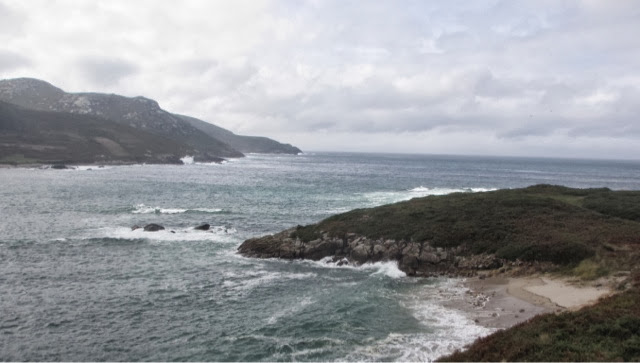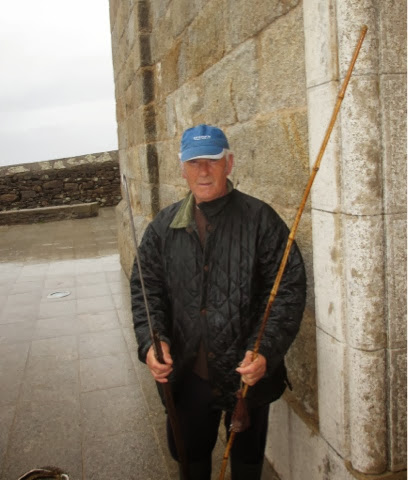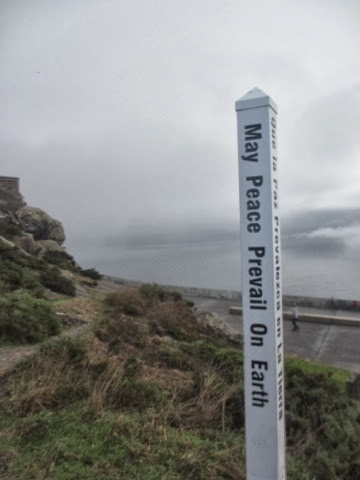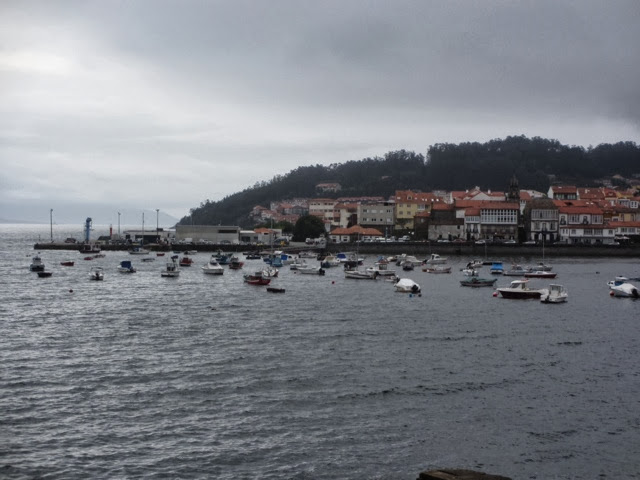We liked Muxia best, just seemed more colorful and had a nice feel. Here are some pix, first as we arrived, walking along the edge of the pavement of the highway into town, a very pretty beach:
Fortunately, we came to a sidewalk, but there seemed to be something very strange about it, when we got closer, we discovered the locals had covered the sidewalk with some sort of seaweed they were letting dry. Reminded me of the dulse we used to eat in Nova Scotia. Didn't taste any to confirm!
And into the town itself, a great place for wave watching:
The far end of this concrete pier seemed to be the gathering place for children and families, with a fenced playground safely away from the crashing waves:
In the morning, after a night of heavy rain, we took advantage of a break in the storm to climb the rocky peak at the edge of town, with great views looking back and out into the waves. I don't recall ever being in winds so strong -- hard to convey in a pic, but you can see Jan's clothes all billowy -- fortunately a tailwind:
From the top, with the crashing waves on the right, the sheltered harbour on the left and the entire town squeezed in between. A stone cross in the left foreground. I fell right beside it, due to the crazy wind, and clonked my elbow on the rock:
Then the heavy rains resumed and we found some shelter in the doorway of a church built at the water's edge and did some storm watching. Very impressive:
We stood there, just barely out of the storm, until the winds shifted and we had to leave. During the walk back to down we got royally drenched -- it was an absolute cloudburst. We had left our packs at the albergue, and inside them our rain pants, but our shoes and socks were the biggest causality -- completely soaked. I wondered if the town (Mooshia) got its name from the sound made of people plodding along in soaking wet shoes.
When we got back to town, we came across a few locals sitting on benches under an overhang, so we grabbed a bench just around the corner from them and caught our breaths. Turned out this place was the police station, but no one seemed to mind us sitting there:
After slightly drying off, we mooshed over to a local cafe for a cafe con leche and we felt human again. By now, the albergue (Bela-Muxia) would have reopened and we could claim our packs, but it was still 2 or 3 hours till our bus would leave for Santiago. We asked the hospitalero at the albergue if we could sit and wait for our bus there -- "No problem!". He had also suggested to us that we leave our packs there before we went out, so I wasn't surprised. We sat in the kitchen with a few other drowned pilgrim rats and ate some lunch (boiled eggs from dinner, with mayo on a baguette) while the storm raged outside. He was such a nice man -- hugged Jan, and gave me a warm two-handed handshake, as we left.
The storm finally broke just before the bus left. Our boots were too wet to wear, so we put them in our packs and wore our sandals - much more comfortable.
Riding in the bus after six weeks or so of only traveling by foot was a bit surreal and sad at the same time. But when the clouds burst again after a short while on board, we were thankful to be inside, in a comfortable seat on a bus back to Santiago. We'd stay two more nights at the Lasalle Albergue/Hotel in Santiago (same place we stayed at week earlier), then on Sunday take the train to Madrid, where we'd spend three nights, then fly home, sweet home.
We'll be spending the time reflecting on our journey, lessons learned etc and likely do a few more posts to tie things up.




















































